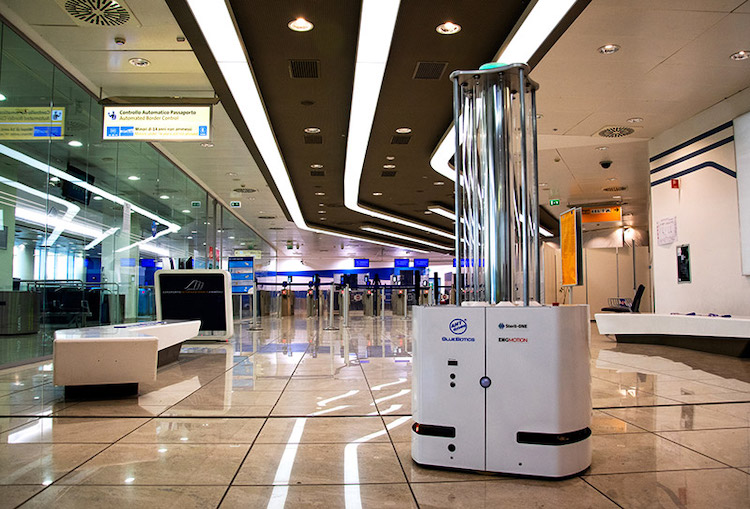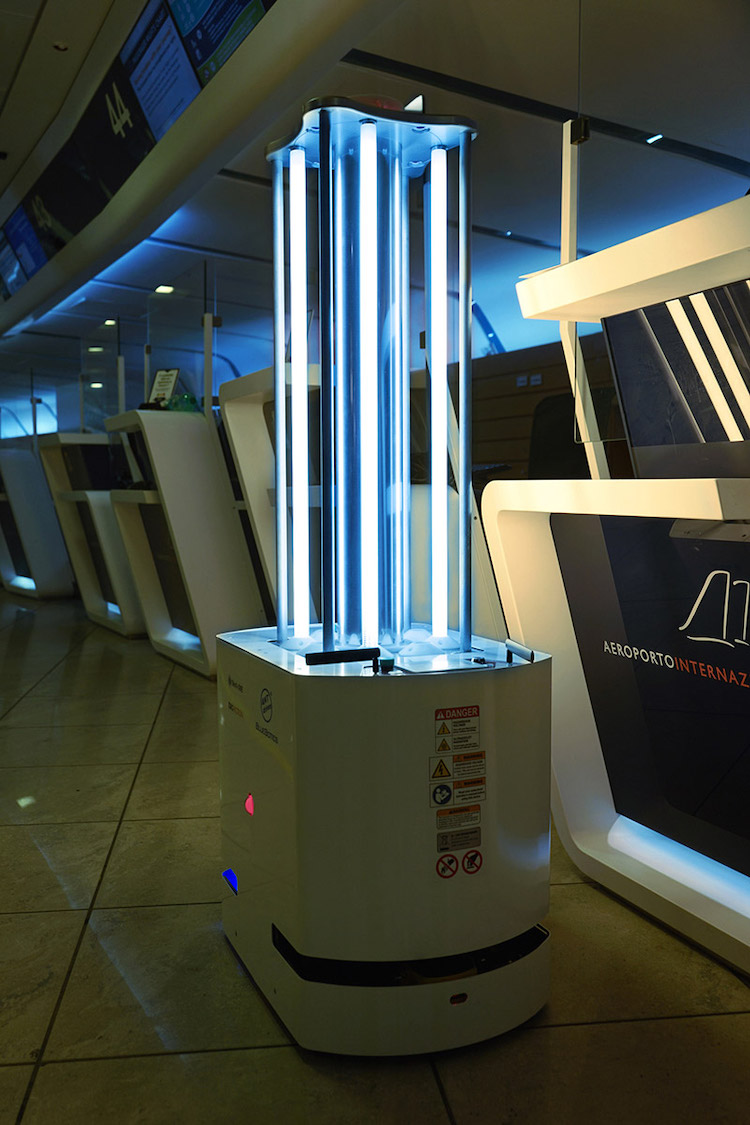
Robots help fight the war against infectious disease
The threat of the spread of viruses is not something new, but the recent COVID-19 pandemic has sparked many responses, socially, medically, and technologically.
Managers of large, public buildings are under increasing pressure to disinfect ‘high-touch’ areas more deeply, often, due to the virus, with minimum staffing levels.
The need to do more to stop the spread of viruses in these busy public spaces led to two companies that are leaders in their fields combining forces to produce a new, highly capable, “mini UVC” robot for the safe, autonomous disinfection of public buildings.
“Unprecedented times require innovative solutions. The challenges that busy public places such as hospitals, airports, hotels, residential homes, and cafeterias face, is how to disinfect big areas with enough frequency to help prevent the spread of viruses.
When Engmotion approached BlueBotics looking for a partner to mobilize its UVC sterilizer technology, the fit between our companies was a natural one,” said Dr. Nicola Tomatis, CEO of BlueBotics.

The most common form of ultraviolet (UV) radiation comes from sunlight, but there are different types of UV rays.
UVC is the highest energy portion of the UV radiation spectrum and has been successfully used for many years to disinfect air, water, and surfaces to help mitigate the risk of the spread of infection due to bacteria or viruses.
Termed ultraviolet germicidal irradiation (UVGI), hundreds of pathogens, including coronaviruses, have been shown to respond to this form of disinfection.
The International Ultraviolet Association (IUVA) states: “COVID-19 infections can be caused by contact with contaminated surfaces and then touching facial area. COVID-19 virus can live on plastic and steel surfaces for up to 3 days.
Normal cleaning and disinfection may leave behind some residual contamination, which UVC can treat suggesting that a multiple disinfectant approach is prudent.
UVC has been shown to achieve a high level of inactivation of a near-relative of COVID-19’s virus (SARS-CoV-1). IUVA believes similar results can be expected when treating COVID-19’s virus, SARS-CoV-2.” (Source)
Enrico Merlani, CEO of Engmotion, said, “UVC light is proven to destroy up to 99% per cent of viruses on surfaces, including the SARS family of viruses, and vegetative bacteria.
However, static lamps require trained staff to place and move them. BlueBotics’ robots based on automated navigation technology (ANT) are a leading solution for large work spaces and, when we started talks with them, we quickly realized we could make an important tool for the fight against the spread of infectious disease.”
Following discussions between the two companies, a joint development project was undertaken to produce a highly effective cleaning solution for large buildings. BlueBotics used its expertise to optimize the size and power of the robot to be used with the powerful Engmotion Steril-ONE UVC sterilization lamp.
“One of the key challenges was the battery. We needed to ensure that we had a lamp with enough power to provide effective disinfection, but we also needed a long enough run time for the robot to be effective in large spaces,” said Tomatis.
The result of the partnership, the mini™ UVC robot, provides powerful UVC sanitization with four hours operation from a single charge and can fully re-charge in as little as three hours.
The ANT based mobile robots have been proven thousands of times in the field to provide reliable, autonomous, semi-autonomous (if staff need to open doors), or manual (via a wired controller with personal protective equipment) coverage of large buildings or spaces.
UVC radiation is dangerous to living organisms and is naturally filtered from sunlight by the Earth’s ozone layer.
Therefore, safety is of paramount importance for the use of any mobile UVC solution. Systems need to reliably detect objects or people when they are in transit and automatically shut down if they detect movement in the area they are working.
Designed to cover areas of differing sizes, systems also need to be scalable, with multiple robots able to work in a coordinated way.
Why mobile UVC?
There is little argument that UVC is a powerful solution in the fight against infectious disease and the radiation has been widely used as a disinfectant for many years.
But why is mobilizing this solution so important? It is because only surfaces which are heated by the UVC rays are disinfected.
This means, if an object is in front of a static lamp, pathogens in the shadows behind it are not neutralized. In relatively small spaces, where there is no overnight activity, such as a dental surgery, static lamps are ideal.
In larger spaces, such as airports, or places with 24/7 activity, such as hospitals, a mobile solution with the appropriate safety features provides much more efficient and comprehensive disinfection.
Such systems, however, must perform consistently to assure users’ disinfection targets are met. They must also operate reliably and predictably should they come into contact with an obstacle and, to ensure absolute safety, sense movement which would indicate a human presence.
Of course, a mobile UVC solution also needs to be easily adaptable to different environments and work fully autonomously (after all, there is little point in employing a robot if a member of staff must follow it around everywhere!)
This requires an advanced, flexible navigation approach and, to allow for use in various sizes of location, the ability for multiple robots to be linked together in a coordinated ‘fleet’.
Applications
Although the mini UVC robot was inspired by the dire consequences of COVID-19, UVC light is proven to destroy more than 99 per cent of viruses on surfaces, making this mobile disinfectant solution ideal for numerous applications.
It should be noted that UVC light does not replace manual cleaning but augments it, as a final stage to help ensure more complete disinfection of an area.
In hospitals, the use of UVC rays for disinfection is not uncommon. A mobile solution means medical organizations can achieve more intensive cleaning without additional staff – a point that is particularly poignant while we are still in the throes of a pandemic.
But mobile UVC solutions are not just for wheeling out when there is a pandemic, they deal with a whole spectrum of pathogens, meaning they can help prevent secondary infections in patients.
Secondary infections are purported to cost hospitals millions every year. In the UK, for example, it was estimated that, in 2016/17, healthcare associated infections (HCAI or HAI) accounted for a total of 5.6 million occupied hospital bed days and 62,500 days of absenteeism among front-line healthcare practitioners, with an estimated total cost to the National Health Service (NHS) of £2.1 billion. (Source)
In the USA, one report estimates around 1 in 25 inpatients having an infection related to hospital care, which leads to tens of thousands of deaths, and costs the U.S. health care system billions of dollars each year. (Source)
UVC disinfection offers the potential to reduce the rate of secondary infections by up to 40%, saving lives and offering hospitals a rapid return on investment for the technology.
In busy airports and stations, COVID-19 has highlighted the need for more in-depth and frequent disinfection. Mobile UVC solutions offer operators the ability to provide more thorough cleaning at an increased frequency without the need for additional human resources.
The primary motivation for this, of course, is human safety, but the use of these systems offers an extra differentiator to airports looking to attract customers and increase footfall.
Indeed, the BlueBotics mini UVC disinfectant robot has already undergone a successful trial at one of Italy’s international airports as part of the site’s strategy to re-open, post-COVID, in an efficient and safe way.
In large offices, mobile UVC solutions offer the potential to reduce lost working hours through sickness and to encourage people back to work in a post-COVID-19 era. For office landlords, the more thorough cleaning routine provides additional incentive for prospective tenants.
As with all applications, disinfectant robots have the possibility of reducing cleaning costs and ensuring quicker disinfectant cycles of large areas.
Summary
The partnership between Engmotion and BlueBotics has combined a proven, powerful UVC disinfectant solution with highly adaptable and easy to use autonomous mobility technology.
The resulting mini UVC disinfection robot provides comprehensive disinfecting, reliable and consistent performance, enhanced safety features, and complete scalability.
More than anything, however, this autonomous UVC robot offers organizations another weapon against the spread of infectious diseases, in a form that could help save the lives of staff and customers as well reducing the costs of day-to-day operations.


